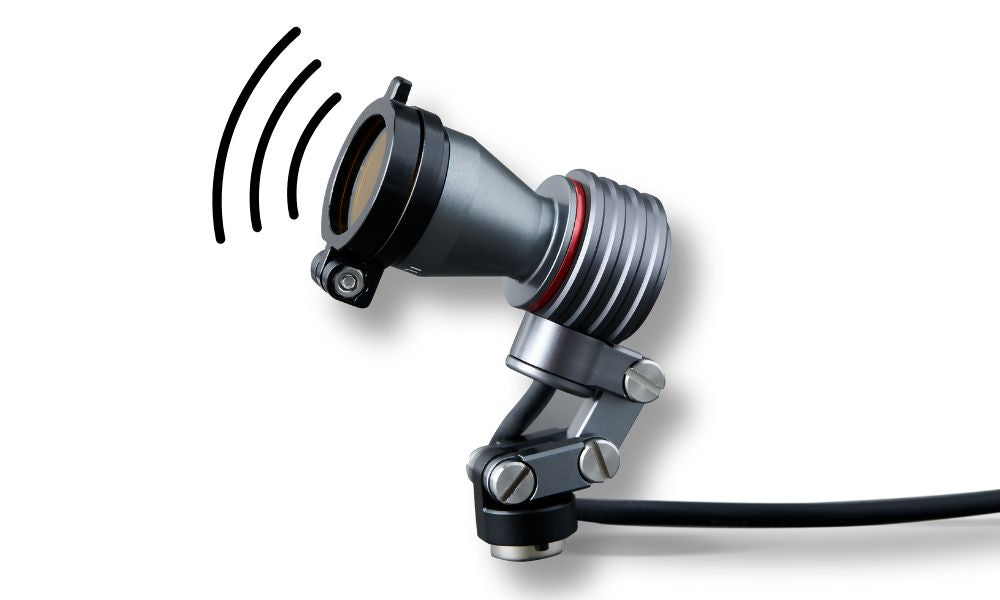Seleccionar el aumento adecuado para sus lupas es clave para mejorar tanto la precisión como la comodidad en su consulta. El aumento se refiere esencialmente al tamaño con el que se ven los objetos a través de las lentes en comparación con el ojo humano. Por ejemplo, con un aumento de 2,5x, un objeto se verá dos veces y media más grande. Si bien este es el punto de partida, hay otros aspectos a considerar al elegir las lupas adecuadas para sus necesidades.
Varios factores influyen en la eficacia con la que la ampliación funcionará para usted: su distancia de trabajo, la ubicación de las lentes en relación con sus ojos y la calidad de las lentes y el diseño del marco.
Distancia de trabajo: una consideración crítica
La distancia de trabajo (el espacio entre la lupa y el objeto) influye considerablemente en el aumento necesario. Si trabaja a mayor distancia del objeto, necesitará un aumento mayor para ver con el mismo nivel de detalle que si estuviera trabajando de cerca. Por ejemplo, un aumento de 2,5x a una distancia de trabajo de 38 cm equivale a ver un objeto a 15 cm sin aumento. Pero si aumenta la distancia de trabajo y desea la misma claridad, podría necesitar un aumento de 4,5x o incluso 6,5x.
La clave está en equilibrar el aumento con una distancia de trabajo cómoda que le permita mantener una postura ergonómica adecuada. Forzar demasiado el cuello y la espalda al inclinarse para ver detalles más finos puede provocar molestias a largo plazo, por lo que es crucial contar con el aumento adecuado a su distancia de trabajo natural.
Distancia ocular y campo de visión
Otro factor importante es la distancia entre los ojos y las lentes oculares, que afecta directamente el campo de visión. Cuanto más cerca estén los ojos de las lentes, más amplia será la visión. Esta es una de las razones por las que muchas lupas se fabrican con tecnología "A través de la lente" (TTL), que permite que las lentes se acerquen más a los ojos y maximicen el campo de visión.
Además, los diseños TTL, junto con características de la montura como la inclinación pantoscópica, garantizan una mejor ergonomía. Al inclinar las lentes correctamente, la inclinación pantoscópica no solo mejora la línea de visión, sino que también ayuda a reducir la tensión en el cuello y los hombros, permitiendo una posición más natural de la cabeza.
Por qué es importante la calidad de la construcción
No todas las lupas son iguales, y los materiales utilizados en su fabricación influyen significativamente en su rendimiento general. Las lupas de alta calidad, como las de ILLUCO, utilizan recubrimientos BBAR (antirreflejos de banda ancha), diseñados para proporcionar una claridad y una transmisión de luz óptimas. Esto garantiza que pueda trabajar durante largos periodos sin fatiga visual.
Las lupas de fabricación superior también ofrecen un campo de visión más amplio y una mayor profundidad de campo. Estas características son esenciales para cambiar el enfoque fácilmente y mantener una imagen nítida en varios planos focales. Para los profesionales que trabajan en campos que requieren atención al detalle, como la odontología o la cirugía, este nivel de claridad y flexibilidad marca la diferencia.
El equilibrio entre la ampliación
Es importante tener en cuenta que, a medida que aumenta el aumento, tanto el campo de visión como la profundidad de campo disminuyen. A mayores aumentos, verá una porción más pequeña del objeto enfocado, lo que puede requerir ajustes más frecuentes. Sin embargo, la posibilidad de mover la cabeza y reenfocar compensa esta limitación, garantizando que pueda mantener la claridad y la precisión, incluso con mayores aumentos.
Aumento adaptado a sus necesidades
En definitiva, elegir el aumento adecuado se trata de encontrar el equilibrio que se adapte a su práctica clínica. Ya sea dentista, veterinario o cirujano, seleccionar el aumento adecuado le garantiza trabajar con comodidad y ver todos los detalles necesarios para realizar sus tareas con precisión.
Con la gama de opciones de aumento y diseños ergonómicos de ILLUCO , puede encontrar lupas que brindan claridad visual y comodidad duradera, lo que lo ayuda a desempeñarse mejor y reduce la tensión física con el tiempo.





Dejar un comentario
Todos los comentarios se revisan antes de su publicación.
Este sitio está protegido por hCaptcha y se aplican la Política de privacidad de hCaptcha y los Términos del servicio.